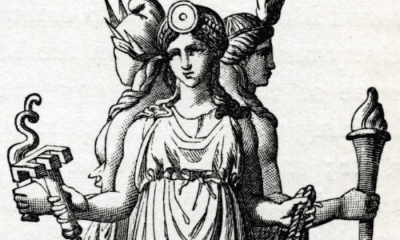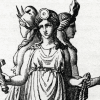Greek
How to Beat the Minotaur
If you want to defeat the infamous bull-headed monster of Crete, you’ll need courage, strength, and more than a little help.
The Minotaur terrorized the island of Crete and devoured the young people of Athens before being defeated by a single brave prince. How did Theseus manage to slay the monstrous man with the head of a bull, though?
In many stories of Greek heroes, simple strength or mastery of a weapon is enough to kill a monster. Often the heroes also have the help of the gods and exceptional intelligence to outwit their foes.
Occasionally, the heroes also had help from other mortals in their fights. When Heracles fought the Hydra, for example, his nephew held the torch to cauterize the monster’s wounded necks.
Theseus had all of this help, in addition to a fair amount of luck and courage. Beating the Minotaur was no simple task, but with the help of King Minos’s own daughter the Athenian prince was about to destroy the Cretan monster.
Theseus and the Defeat of the Minotaur
The Minotaur was a vicious, man-eating monster who terrorized the island of Crete. To save his own people, King Minos commanded the architect and inventor Daedalus to construct an inescapable prison for the beast.
The result was the Labyrinth, a massive twisting maze deep beneath the palace of Knossos. The Minotaur was shut inside, unable to find its way out in the dark.
The problem remained, however, of keeping the monster fed. Crete had recently waged war against Athens and settled the problem by demanding the conquered city send young men and women to be sacrificed to the monster.
Theseus was an Athenian prince who had been raised among his mother’s people in Troezen. When he went to his father’s kingdom and discovered that a sacrifice was about to be sent to Crete, he insisted on being included among the intended victims.
Theseus had already begun establishing a reputation as a hero by defeating various monsters during his journey to Athens. He intended to put that experience to use against the Minotaur.
According to most versions of the legend, Theseus managed to hide a sword in his clothing when he arrived on Crete. The weapon, however, would not be his most valuable tool in the battle against the monster.
Theseus would receive the most aid from the daughter of King Minos, Ariadne. When the princess saw the young man arrive at Knossos she fell instantly in love and could not bear for him to be killed by her father’s monster.
Ariadne was willing to help Theseus but she could not do much on her own. She turned to the Labyrinth’s architect, Daedalus, for help.
Daedalus himself had been imprisoned by Minos and was disgusted by the human sacrifices taking place within his creation. He helped Ariadne devise a plan to aid Theseus in his quest.
Ariadne freed Theseus from the cell he was being held in the night before he and the other Athenian youths were to be sent into the Labyrinth. She took him to the maze-like prison’s entrance and told him her plan.
No matter how strong and brave he was, Theseus would never be able to find his way through the dark tunnels of the Labyrinth. Ariadne had received some directions from Daedalus, but the maze had been designed to be confusing.
The princess told Theseus how to reach the center of the maze, but knew he would not be able to find his way back out after the fight. To help him, she tied a piece of string to his clothing.
As Theseus ventured into the Labyrinth’s dark tunnels, the spool of thread unwound behind him. Ariadne remained at the door to hold the end of the long string.
Using Daedalus’s directions, Theseus was able to find the sleeping Minotaur in the center of the Labyrinth. He pulled out his hidden sword to fight the beast.
According to some writers, Theseus was able to defeat the beast because of his swordsmanship. Others, however, claimed that the hero lost his weapon in the fight and had to use brute force, strangling the monster in hand to hand combat.
Theseus would have been lost in the Labyrinth if not for the string Ariadne had given him. Athena’s inspiration had given the Minoan princess the wisdom to ensure the hero had a means of escape.
Theseus followed the thread back to the entrance where the princess waited for his victorious return. Together, the left Crete with the intent to marry, although their further adventures would lead to their separation.
To beat the Minotaur, Theseus needed more than just his own heroism. He needed the help of Ariadne and Daedalus, the wisdom of Athena, and the luck to be able to smuggle his sword and reach the Labyrinth’s entrance without detection.
My Modern Interpretation
The story the Minotaur was probably rooted in the ancient religion and rituals of the island of Crete. Separated from the mainland, Crete always had a distinct culture that set it apart from that of mainland Greece or its affiliated colonies.
The Minoan culture, named for the legendary King Minos, predated that of the Mycenean Greeks. When the legends of classical Greece were written down, depictions of Crete were influenced by more ancient stories and the still-visible ruins of the Minoan culture.
While the earlier writings of Crete have not been deciphered, archaeology helps to show how the Greek stories were influenced by earlier Minoan religion.
Bulls seem to have formed an important part of that religion, with many historians believing that a bull cult was one of Crete’s most important religious institutions. Altars were sometimes topped with bull horns and many frescos and statues found on the island depict men and women alike leaping over the horns of oversized bulls.
At its height, the capital city of Knossos was the center of the most powerful civilization in Europe. With a strong hold on trade and superior technology, the Minoans began to colonize mainland Greece.
In the pre-Greek era, small cities of the time like Athens would have been under the sway of the more powerful Minoans.
The story of the sacrifice of Athenian youths to a monstrous half-bull may have roots in an actual tradition. Not enough is known about the Minoan religion to know if human sacrifices were performed or if foreign children were simply taken to serve the Minoan temples.
With this in mind, modern scholars have sought to interpret the legendary Minotaur and its place in history. Its death at the hands of the Athenian prince could symbolize the rise of Athens, as a part of mainland Greek culture, and the decline of Crete as the cultural and political capital of the Mediterranean.
If the story of Theseus was inspired by historical facts, it is unlikely that a single Athenian prince defeated the might of Knossos. Instead, the story may be an allegory for a Greek military victory on the island that ended Crete’s control over Greek cities like Athens.
The inclusion of Minoan helpers, Ariadne and Daedalus, could be a romantic addition to the legend. Or it could be rooted in a long-forgotten historical event in which residents of Knossos lent aid to an Athenian army.
The defeat of the Minotaur can therefore be seen as something greater than the story of killing a single monster on Crete. Beating the Minotaur meant beating an entire civilization in a battle for economic and political power over the entire Mediterranean.
In Summary
The defeat of the Minotaur is one of the most famous legends of the Athenian hero and founding king, Theseus.
The prince already had a reputation for defeating monsters when he insisted on being sent to Crete. He was among a cohort of Athenian youths who were doomed to be fed to the Minotaur under the orders of King Minos.
Theseus, however, intended to kill the monster. He smuggled a sword within his clothing, hoping to have an opportunity to kill the monster when he was shut in the Labyrinth.
He did not have to complete his quest alone, however. The princess of Knossos, Ariadne, fell in love with him and decided to aid him in his task.
With the help of the inventor Daedalus and the goddess Athena, Ariadne freed the Athenian hero and devised a plan to guide him through the maze-like Labyrinth. She used a large spool of thread to guide Theseus out of the dark corridors after he beat the monster.
Beating the Minotaur took courage and strength, but it would have been impossible without help from both other people and the gods.
The defeat of the Minotaur was more than just a fight against a single monster, however. The story most likely references a historical period in which Mycenaean Greece and Minoan Crete vied for control over the Eastern Mediterranean.
To beat the Minotaur took strength and assistance. The monster’s story, however, is probably an allegory for the use of an army and local saboteurs to defeat a powerful nation.



